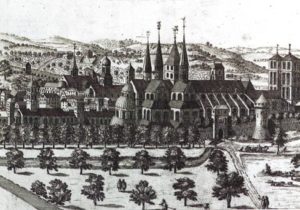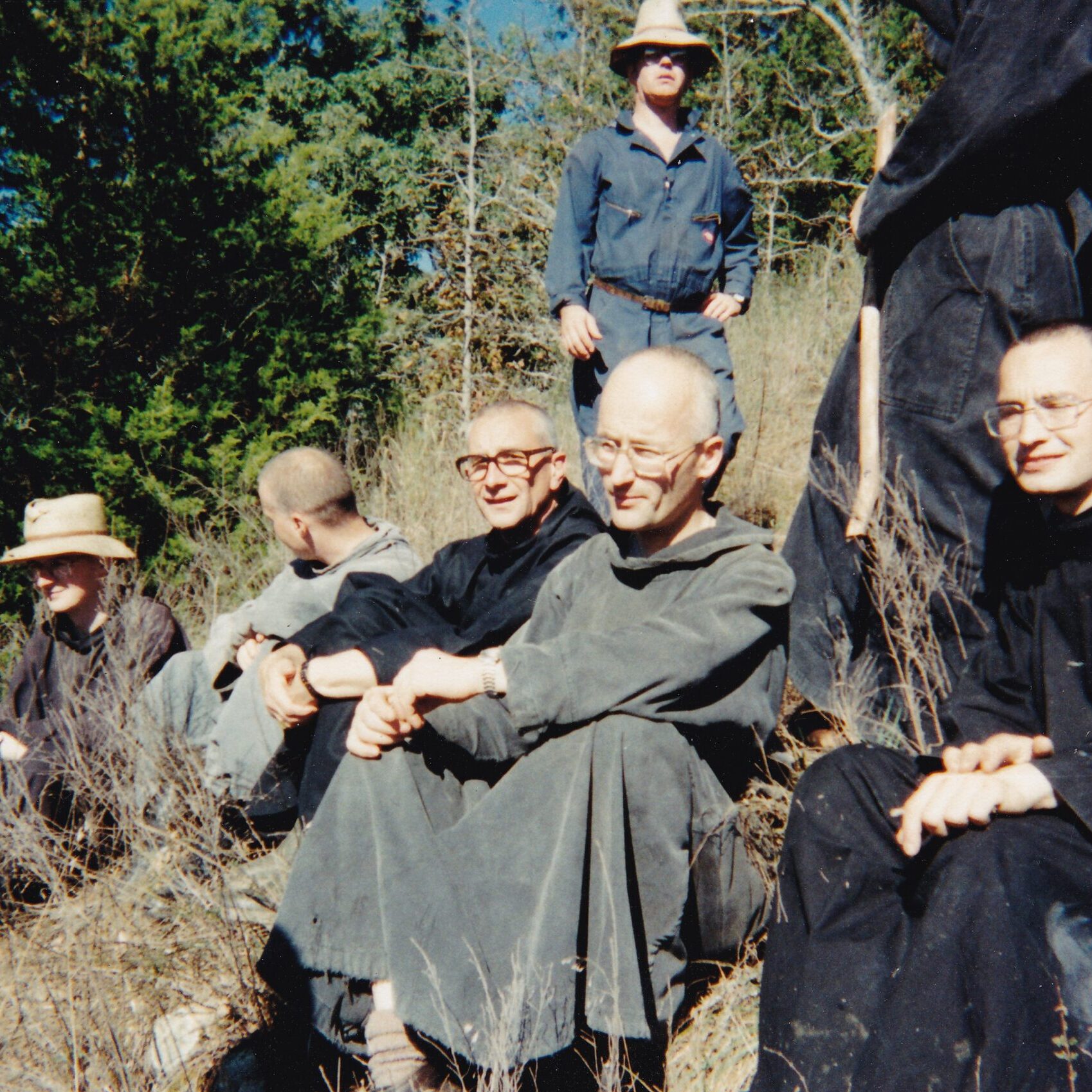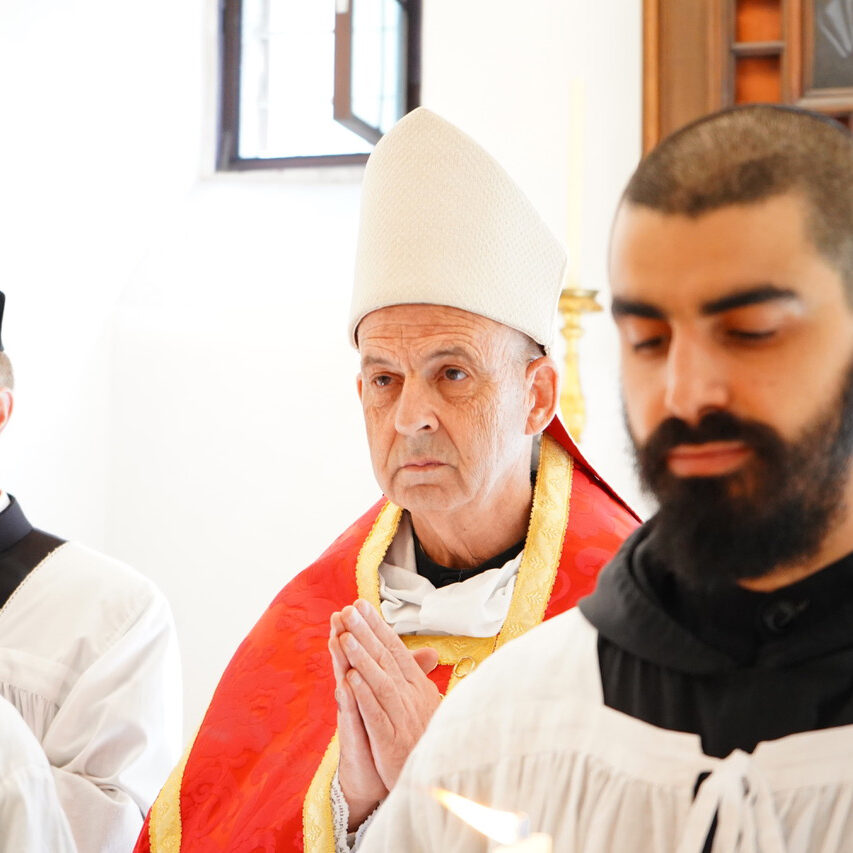Dear Friend of Clear Creek Abbey,
 It is said that at the Abbey of Cluny such were the spaciousness of its buildings and the good order of its grounds and appurtenances, that the Pope, the Emperor, and several kings with numerous suites could be received simultaneously as guests without impairing the tranquil regularity of monastic life. Truly, this monastery was a spiritual citadel, a monastic “keep” at the heart of Christendom.
It is said that at the Abbey of Cluny such were the spaciousness of its buildings and the good order of its grounds and appurtenances, that the Pope, the Emperor, and several kings with numerous suites could be received simultaneously as guests without impairing the tranquil regularity of monastic life. Truly, this monastery was a spiritual citadel, a monastic “keep” at the heart of Christendom.
As a member of the Solesmes Congregation, Our Lady of Clear Creek Abbey is a spiritual heir of Cluny. By decree of Pope Gregory XVI in 1837, our Congregation replaced the ancient Congregation of Cluny and several others that disappeared during the French Revolution. The spiritual and material greatness of Cluny does not make us great by any means, but we see in this page of monastic history a precious heritage to be preserved. I would like to share some of it with you.
The history of this Benedictine monastery located in Burgundy (now part of France) spans some 880 years from its establishment by William I, Duke of Aquitaine, in 910 to the execution of its last monks during the religion persecution of the Constituent Assembly in 1790. Cluny gave to the Church four Popes, including Blessed Urban II, who in 1098 called his former monastery the “light of the world.”
The great abbey also provided a number of saintly statesmen—mostly abbots—who, as trusted counselors to Popes and Emperors, had a considerable effect on the history, both religious and political, of the Western world during the Middle Ages. For instance, Saint Odilo, the fifth abbot of Cluny, vigorously promoted the “Truce of God,” whereby belligerent Christian lords had to limit fighting among themselves to certain days of the week. He also instituted the Commemoration of All Souls on November 2nd, a liturgical practice later adopted by the universal Catholic Church. Cluny’s church, demolished in the aftermath of the French Revolution, was the largest in Christendom until St. Peter’s Basilica in Rome was built. The monastery buildings alone covered some 25 acres of grounds.
The Abbey of Cluny truly set the standard for monastic observance in the West for several centuries, having up to 825 monasteries throughout Europe under its authority—many more if one counts the monasteries that followed its customs without being directly affiliated with the Burgundy mother-house. There seem to have been about 10,000 monks at Cluny and its dependent houses in the 11th century, which would be something like 60,000 today, given the growth of the European population.
Perhaps the most important characteristic of the history of this great abbey was its role in the reform, both of monastic life and of the Church in general. The initial step was to bring monastic life back to its purity of discipline, something that was accomplished first at Cluny, then in the hundreds of monasteries that underwent the same reform of manners under its influence.
But there was a more difficult challenge. Great was the corruption of the Church after a millennium of Christian history, mostly due to the crime of simony (the buying of ecclesiastical privileges), to unchaste behavior among the clergy, and to what is called “lay investiture,” that is to say the appointment of bishops, abbots, and other church officials by feudal lords. In other words, it was the king instead of the Pope who decided who would be a bishop! An immense struggle ensued over this issue, pitting the Pope against the Holy Roman Emperor. The monks of Cluny—sometimes abandoned by all other allies—took the side of the papacy, particularly in the wake of the reform initiated by Pope Saint Gregory VII (himself, perhaps, a former Cluniac monk). Their role was a vital one. Little by little, the Church regained control of its own destinies.
What part may monks have in our own time? The world’s stage is vastly changed since the Middle Ages. The Church has undergone an immense development, having broadened its physical frontiers to the dimensions of the planet, even though its influence over society in general has declined in a dramatic way, especially in recent decades. In this new context, monks are seldom seen among those who shape the protocol and policies that move the world. Is their time irrevocably past?
As Benedictines, heirs of the Abbey of Cluny, we at Clear Creek know that the fundamental role of monks is not about rubbing elbows with the great of this world or having a preponderate influence in high places. When Saint Benedict left the world to pray all alone in a cave, he changed the course of history more radically than anything accomplished in the time of Cluny. The invisible influence of spiritual prayer at the heart of Europe was the definitive factor. Cluny was a glorious summit, but wholly dependent on the contemplative presence of countless unknown monks in their cloisters. This is just as true today as it was then.
Please help us continue the story… Who knows? Perhaps a new Cluny will emerge in the wilderness somewhere in America. “For with God nothing will be impossible” (Lk. 1:37).
+ br. Philip Anderson, abbot
Dear Friend of Clear Creek Abbey,
 It is said that at the Abbey of Cluny such were the spaciousness of its buildings and the good order of its grounds and appurtenances, that the Pope, the Emperor, and several kings with numerous suites could be received simultaneously as guests without impairing the tranquil regularity of monastic life. Truly, this monastery was a spiritual citadel, a monastic “keep” at the heart of Christendom.
It is said that at the Abbey of Cluny such were the spaciousness of its buildings and the good order of its grounds and appurtenances, that the Pope, the Emperor, and several kings with numerous suites could be received simultaneously as guests without impairing the tranquil regularity of monastic life. Truly, this monastery was a spiritual citadel, a monastic “keep” at the heart of Christendom.
As a member of the Solesmes Congregation, Our Lady of Clear Creek Abbey is a spiritual heir of Cluny. By decree of Pope Gregory XVI in 1837, our Congregation replaced the ancient Congregation of Cluny and several others that disappeared during the French Revolution. The spiritual and material greatness of Cluny does not make us great by any means, but we see in this page of monastic history a precious heritage to be preserved. I would like to share some of it with you.
The history of this Benedictine monastery located in Burgundy (now part of France) spans some 880 years from its establishment by William I, Duke of Aquitaine, in 910 to the execution of its last monks during the religion persecution of the Constituent Assembly in 1790. Cluny gave to the Church four Popes, including Blessed Urban II, who in 1098 called his former monastery the “light of the world.”
The great abbey also provided a number of saintly statesmen—mostly abbots—who, as trusted counselors to Popes and Emperors, had a considerable effect on the history, both religious and political, of the Western world during the Middle Ages. For instance, Saint Odilo, the fifth abbot of Cluny, vigorously promoted the “Truce of God,” whereby belligerent Christian lords had to limit fighting among themselves to certain days of the week. He also instituted the Commemoration of All Souls on November 2nd, a liturgical practice later adopted by the universal Catholic Church. Cluny’s church, demolished in the aftermath of the French Revolution, was the largest in Christendom until St. Peter’s Basilica in Rome was built. The monastery buildings alone covered some 25 acres of grounds.
The Abbey of Cluny truly set the standard for monastic observance in the West for several centuries, having up to 825 monasteries throughout Europe under its authority—many more if one counts the monasteries that followed its customs without being directly affiliated with the Burgundy mother-house. There seem to have been about 10,000 monks at Cluny and its dependent houses in the 11th century, which would be something like 60,000 today, given the growth of the European population.
Perhaps the most important characteristic of the history of this great abbey was its role in the reform, both of monastic life and of the Church in general. The initial step was to bring monastic life back to its purity of discipline, something that was accomplished first at Cluny, then in the hundreds of monasteries that underwent the same reform of manners under its influence.
But there was a more difficult challenge. Great was the corruption of the Church after a millennium of Christian history, mostly due to the crime of simony (the buying of ecclesiastical privileges), to unchaste behavior among the clergy, and to what is called “lay investiture,” that is to say the appointment of bishops, abbots, and other church officials by feudal lords. In other words, it was the king instead of the Pope who decided who would be a bishop! An immense struggle ensued over this issue, pitting the Pope against the Holy Roman Emperor. The monks of Cluny—sometimes abandoned by all other allies—took the side of the papacy, particularly in the wake of the reform initiated by Pope Saint Gregory VII (himself, perhaps, a former Cluniac monk). Their role was a vital one. Little by little, the Church regained control of its own destinies.
What part may monks have in our own time? The world’s stage is vastly changed since the Middle Ages. The Church has undergone an immense development, having broadened its physical frontiers to the dimensions of the planet, even though its influence over society in general has declined in a dramatic way, especially in recent decades. In this new context, monks are seldom seen among those who shape the protocol and policies that move the world. Is their time irrevocably past?
As Benedictines, heirs of the Abbey of Cluny, we at Clear Creek know that the fundamental role of monks is not about rubbing elbows with the great of this world or having a preponderate influence in high places. When Saint Benedict left the world to pray all alone in a cave, he changed the course of history more radically than anything accomplished in the time of Cluny. The invisible influence of spiritual prayer at the heart of Europe was the definitive factor. Cluny was a glorious summit, but wholly dependent on the contemplative presence of countless unknown monks in their cloisters. This is just as true today as it was then.
Please help us continue the story… Who knows? Perhaps a new Cluny will emerge in the wilderness somewhere in America. “For with God nothing will be impossible” (Lk. 1:37).
+ br. Philip Anderson, abbot






